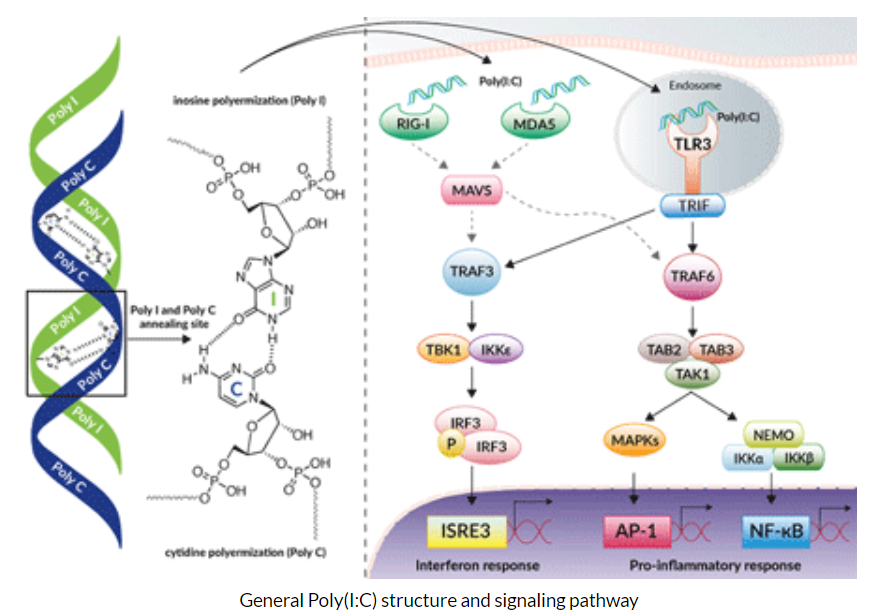Description
Poly(I:C) HMW | tlrl-pic
High molecular weight polyinosine-polycytidylic acid – TLR3 agonist
Polyinosinic-polycytidylic acid (i.e. poly(I:C)) is a synthetic analog of double-stranded RNA (dsRNA), a molecular pattern associated with viral infections. InvivoGen’s Poly(I:C) HMW (High Molecular Weight) is comprised of long strands of inosine poly(I) homopolymer annealed to strands of cytidine poly(C) homopolymer. The average size of Poly(I:C) HMW is from 1.5 kb to 8 kb. Poly(I:C) HMW is functionally validated for TLR3 potency using HEK-Blue™ TLR3 Cells and the absence of contaminants (e.g. lipoproteins and endotoxin) is confirmed using TLR2 and TLR4 cellular assays, respectively.
Poly(I:C) recognition and signaling
Poly(I:C) is structurally similar to dsRNA, present in some viruses, and is therefore commonly used to model the actions of extracellular dsRNA.
Upon binding to its receptors, poly(I:C) is able to selectively activate numerous signaling pathways depending on the conditions. Poly(I:C) is recognized by endosomal Toll-like receptor 3 (TLR3) [1, 2]. Upon recognition, TLR3 activates the transcription factor interferon regulatory factor 3 (IRF3), through the adapter protein Toll-IL-1 receptor (TIR) domain-containing adapter (TRIF, also known as TICAM-1) [3]. Activation of IRF3 leads to the production of type I IFNs (e.g. IFN-β). Additionally, recognition of poly(I:C) can lead to the recruitment of TNF receptor-associated factor 6 (TRAF6) or receptor-interacting protein 1 (RIP1), with the subsequent activation of the transcription factors NF-κB and AP-1 [4]. Activation of these pathways triggers the production of inflammatory cytokines and chemokines such as TNF-α, IL-6, and CXCL10. Furthermore, poly(I:C) may activate the cytosolic RNA helicases retinoic acid-inducible protein I (RIG-I) and melanoma differentiation-associate gene 5 (MDA-5) [5].
Due to its ability to induce signaling via multiple inflammatory pathways, poly(I:C) is known to increase vaccine immunogenicity, especially in formulations that target dendritic cells. It has been shown that the superior qualities of poly(I:C) as a vaccine adjuvant may be due to synergy between TLR3 and MDA-5 activation [6].

Key features of Poly(I:C) HMW:
- Potent activator of TLR3
- Functionally validated
- Highly cited in the literature for both in vitro and in vivo assays
- Pre-labeled and guaranteed sterileVacciGrade™ Poly(I:C) HMW forms are also available
Specifications
CAS number: 31852-29-6
Working concentration: 30 ng - 10 μg/ml
Solubility: 1 mg/ml in physiological water (NaCl 0.9%) heated for 10 minutes at 65 - 70°C
Quality Control:
- Absorbance spectrum
- TLR3 activity has been verified using HEK-Blue™ TLR3 cells
- The absence of bacterial contamination (e.g. lipoproteins and endotoxins) has been confirmed using HEK-Blue™ TLR2 and HEK‑Blue™ TLR4 cells.
Contents
Poly(I:C) HMW is provided lyophilized and with sterile endotoxin-free physiological water (NaCl 0.9%).
It is available in two quantities:
- 10 mg (#tlrl-pic) with 10 ml of sterile endotoxin-free physiological water
- 50 mg (#tlrl-pic-5) with 2 x 25ml of sterile endotoxin-free physiological water
Poly(I:C) HMW is shipped at room temperature
Upon receipt store at 4°C. Upon resuspension, prepare aliquots and store at -20°C for long term storage. Store at 4°C for short term storage.
stable Lyophilized product is stable 1 year at 4°C when properly stored.
stable Resuspended product is stable 1 month at 4°C and 1 year at -20°C.
Alert Avoid repeated freeze-thaw cycles.








